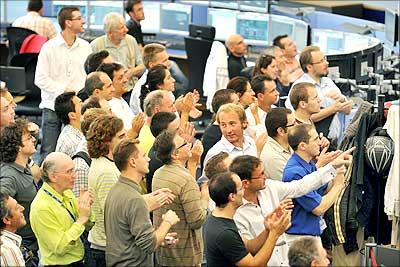
Physicists around the world last night celebrated the first tests of the Large Hadron Collider which they hope will unlock the secrets of the universe and its origins.
The Large Hadron Collider (LHC) is a gigantic scientific instrument near Geneva, where it spans the border between Switzerland and France about 100 m underground. It is a particle accelerator used by physicists to study the smallest known particles – the fundamental building blocks of all things. It will revolutionise our understanding, from the minuscule world deep within atoms to the vastness of the Universe.
Why LHC?
The LHC was built to help scientists to answer key unresolved questions in particle physics. The unprecedented energy it achieves may even reveal some unexpected results that no one has ever thought of!
How LHC works?
Inside the accelerator, two beams of particles travel at close to the speed of light with very high energies before colliding with one another. The beams travel in opposite directions in separate beam pipes – two tubes kept at ultrahigh vacuum. They are guided around the accelerator ring by a strong magnetic field, achieved using superconducting electromagnets. These are built from coils of special electric cable that operates in a superconducting state, efficiently conducting electricity without resistance or loss of energy. This requires chilling the magnets to about ‑271°C – a temperature colder than outer space! For this reason, much of the accelerator is connected to a distribution system of liquid helium, which cools the magnets, as well as to other supply services.
All the controls for the accelerator, its services and technical infrastructure are housed under one roof at the CERN Control Centre. From here, the beams inside the LHC will be made to collide at four locations around the accelerator ring, corresponding to the positions of the particle detectors.
First Beam


An international collaboration of scientists today sent the first beam of protons zooming at nearly the speed of light around the 17-mile-long underground circular path of the LHC.Celebrations across the United States and around the world marked the first circulating beams, an occasion more than 15 years in the making.
Staff in the control room on the border of Switzerland and France clapped as two beams of particles were sent silently first one way and then the other around the LHC's 27km underground chamber.
It will be weeks or months before two particles ever crash together in the giant tube, and even longer before scientists can interpret results, said Jos Engelen, chief scientific officer of CERN, the European Organization for Nuclear Research.
With a statement like "recreate the big bang", it's hard not to think of this as the end of the world--the last big bang was pretty darn big, we've been told. However, the scientists are quick to point out that this is a controlled environment, and we aren't likely to see a new universe create itself.
And if they're wrong, what can you do?
More to read at NGC and to see at Big Picture
Previous Article: Gates' words



1 comment:
Lets see ... what uncanny news comes next ...
Post a Comment